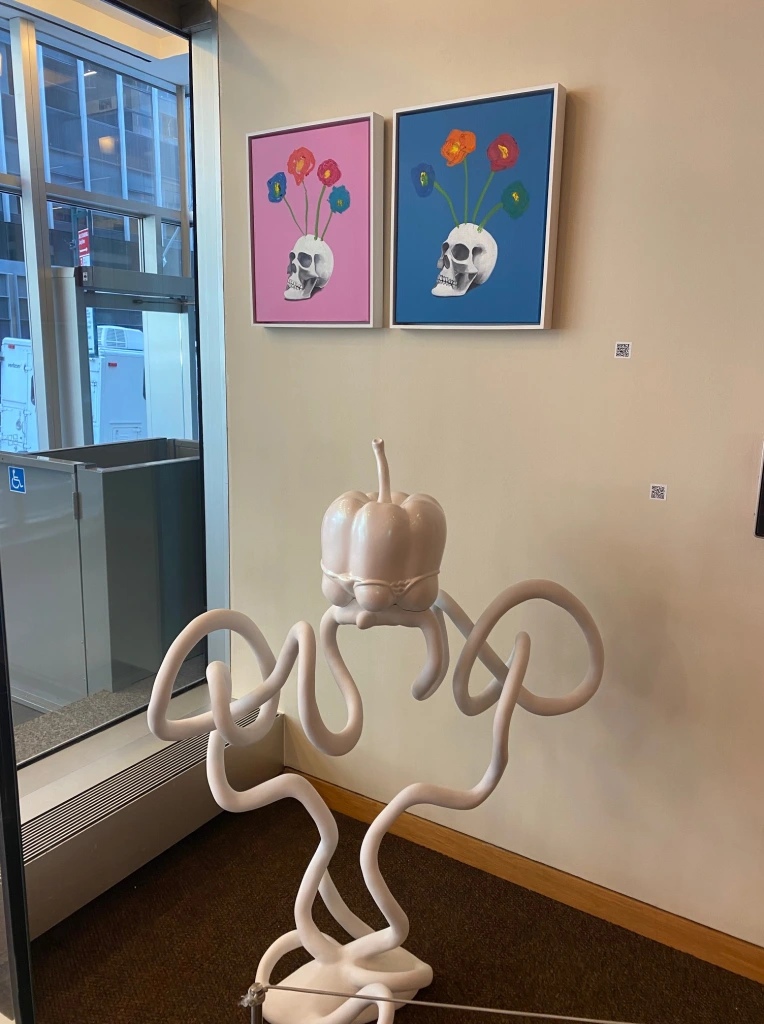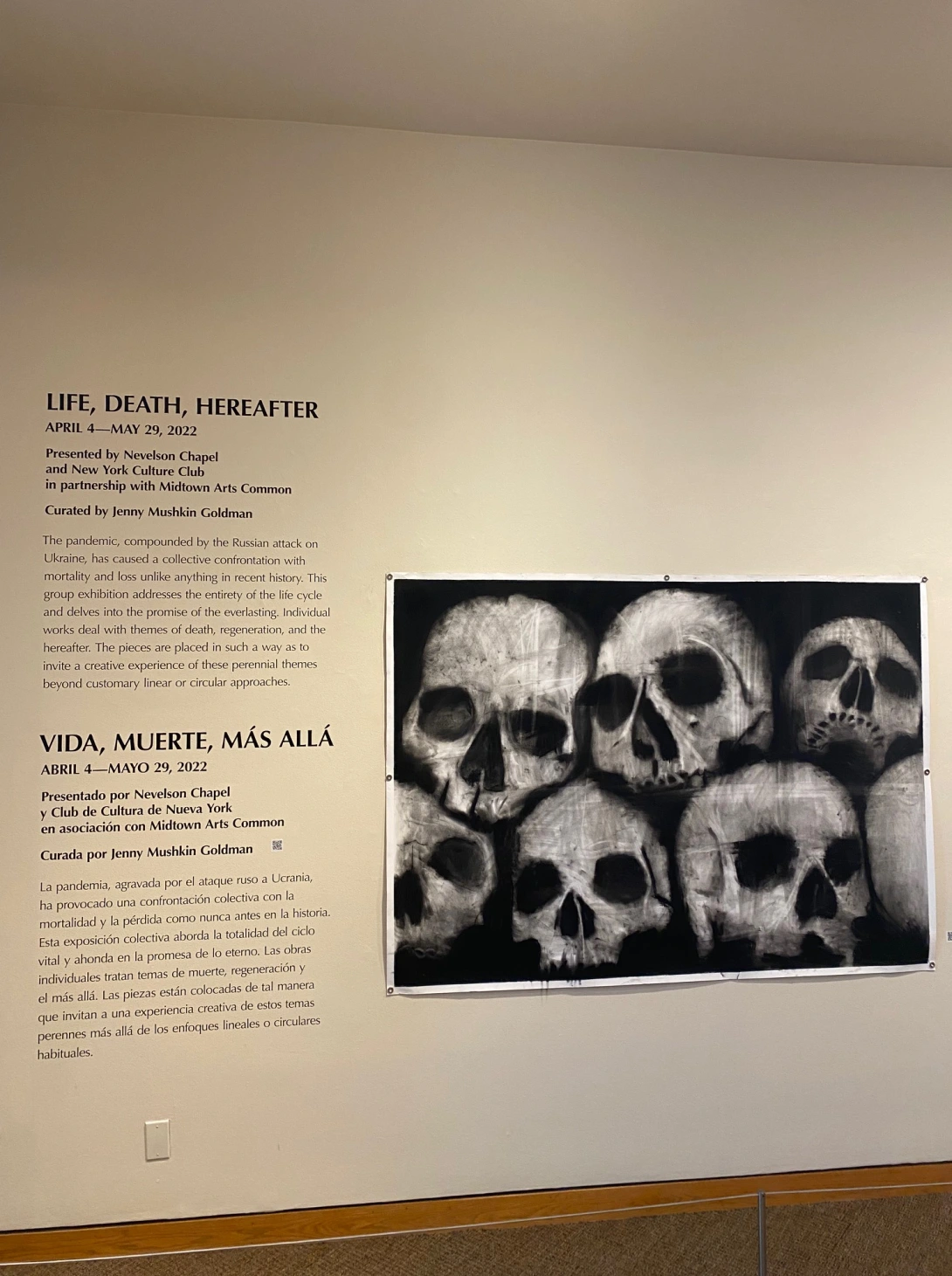Audra Lambert
A visceral and lingering look at death highlights the preciousness of living in ”Life, Death, Hereafter” on view through May 29th at the Nevelson Chapel (Lexington Avenue and 54th Street) in Manhattan. Curated by Jenny Mushkin Goldman, MA, the exhibition is produced in partnership with the Nevelson Legacy Council and NYC Culture Club at Saint Peter’s Church, home of Nevelson Chapel. A space for spiritual engagement and creative vision, the chapel serves as a fitting host for this illuminating exhibition engaging with loss, grief, and spirit.
Intersecting themes around environmental conservation and collective loss expand the conversation outward from a core theme of the individual’s experiences with death. Artists Chellis Baird, Nelsena Burt-Spano, Alexis Duque, S. Klitgaard, Katarra LaRae Peterson, Gracelee Lawrence, April Marten, Ariel Mitchell, Anne-Sophie H. Plume, Lina Puerta, Leonard Reibstein, Adam Umbach, and Paul Joseph Vogeler exhibit compelling artworks engaging with themes both corporeal and spiritual in nature.

Artist S. Klitgaard’s paintings embrace bold color combinations that heighten the emotional tension present in these compositions. Psychological clues pervade the paintings, which create mysterious tableaux for the viewer to contemplate. While Ariel Mitchell’s haunting ”The Blind Search for Frog Eggs” appears abstract at first, the painting actually depicts the swirling of new life as tadpoles emerge from murky water. The careful attention here to color and composition create a dream-like world for the viewer. Works by April Marten, titled ”Death” and ”I Am” are two minimalist, mixed-media text works that communicate austerity, longing and memory. Marten’s sensitive approach to the subject matter forms a powerful elegy to memory and identity.
Leonard Reibstein’s ”Harbinger” produces a phantasmagoric vision packed with medieval elements. The dream-like vision of a levitating castle, along with the harsh color contrasts present in the composition, produce a harrowing effect for the viewer of this quixotic and ominous painting. Adam Umbach’s works combine the concept of memento mori with a Pop Art sensibility. The graphic style of Umbach’s paintings pack a punch in its pared-down visual composition style. Paul Joseph Vogeler’s ”The Violence Within” depicts stacked skulls in monotone in this charcoal on paper work. Vogeler pays careful attention to the formal qualities of these elements, with nuanced details of the crevices and surfaces of these skulls which are both evocative and chilling.
Chellis Baird’s monumental ”Anticipation” is a towering abstract painting that weaves together disparate materials, incorporating wax to create an effect that almost strikes the viewer as organic matter. Baird’s sumptuous and skillful use of material recalls both decay and new growth. Lina Puerta’s installations from her ’Botanico’ series calls to mind both the supernatural allusion of the term and the botanical gardens implied with the faux natural materials creating these aras of verdant overgrowth throughout the gallery. Puerta deftly combines a range of materials to form a hybridized, visceral installation speaking to a wide audience. Alexis Duque paints composite worlds that speak to lost civilizations the dissipating diversity of flora and fauna as a result of climate change and colonization. His intricate compositions create lush worlds that document growth over decay.
Artist Nelsena Burt-Spano’s installation ”XO” is powerful and provocative. Violence and nurturing elements are presented in stark contrast to one another: a visual felt more keenly in the wake of continued incidents of mass gun violence in the United States. “Exodus” by Katarra LaRae Peterson is a diptych artfully portraying the immense and sublime experience undergone by Moses parting the Red Sea. This famed tale from Judeo-Christian history approximates the overwhelming experience felt by refugees escaping to a new life through hazard and hardship. Gracelee Lawrence is exhibiting a sculpture, ”You Can Only Think Clearly With Your Clothes On.” This sculpture feels both precious and tenuous, with sweeping curvature that incorporates 3-D printed abstract and representational elements. Finally, artist Anne-Sophie H. Plume’s Studies of Human Skulls depict expressionist and emotionally charged portraits of skulls, delicate and powerful continuations of memento mori traditions that recall the preciousness of life. Plume’s treatment of this topic marks a contemporary departure from this historic tradition.
Echoing artist Louise Nevelson’s observation that ”we are a mirror of our times,” curator Jenny Mushkin Goldman observes the interlocking themes and how the artwork on view reinforces the show’s premise of considering death in our contemporary moment. ”This group exhibition presents artwork portraying motifs inspired by symbolism related to the inevitability of death,” reflects Mushkin Goldman. ”Other artwork included speaks to the regeneration of life through botanical imagery and materiality evocative of verdant abundance and also brings to mind the Garden of Eden and the notion of paradise lost. Some work presented explores that which is not earthbound, furthering the idea of the continuity of life into the hereafter.”

In moments when we find ourselves dealing with collective grief and loss in society, exploring ways to view this experience artistically can offer new ways to consider the meaning our lives have and to better understand how death affects us from multiple perspectives.
“Death, Life, Hereafter” is on view through May 29th at the Nevelson Chapel. Hours to view the exhibit are Monday to Friday, 10am – 12 pm and Sunday to Tuesday, 4 – 6 pm.


